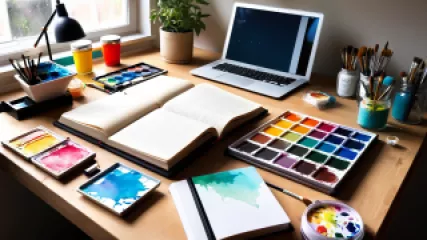How to Get Started with Expressive Arts Therapy: A Step-by-Step Guide
How to Get Started with Expressive Arts Therapy: A Step-by-Step Guide
Expressive arts therapy is a powerful and transformative approach to healing and personal growth. By engaging in a variety of creative modalities, such as painting, writing, movement, and music, individuals can explore their emotions, process past experiences, and unlock new perspectives on their lives. Whether you're seeking to enhance your mental well-being, address specific challenges, or simply tap into your innate creativity, expressive arts therapy can be a profound and enriching journey.
In this comprehensive guide, we'll walk you through the step-by-step process of getting started with expressive arts therapy. From understanding the fundamentals to developing your own practice, we'll cover everything you need to know to embark on this transformative path.
Understanding Expressive Arts Therapy
Expressive arts therapy is a form of psychotherapy that integrates various creative modalities, including visual arts, music, dance, drama, and creative writing. The underlying premise of this approach is that the creative process can be a powerful tool for self-expression, emotional processing, and personal growth.
Unlike traditional talk therapy, expressive arts therapy focuses on the creative process itself, rather than solely on the content or product. By engaging in creative activities, individuals can access and explore their innermost thoughts, feelings, and experiences in a non-threatening and often more accessible way.
The benefits of expressive arts therapy are wide-ranging and well-documented. Studies have shown that this approach can help reduce symptoms of depression, anxiety, and trauma, improve overall mental health and well-being, and foster greater self-awareness and self-acceptance.
Preparing for Your Expressive Arts Therapy Journey
Before you embark on your expressive arts therapy journey, it's important to set the stage for a meaningful and fulfilling experience. Here are some key steps to help you prepare:
1. Reflect on Your Intentions
Take some time to reflect on why you're interested in exploring expressive arts therapy. What are your goals and expectations? Are you seeking to address a specific challenge, enhance your overall well-being, or simply explore your creativity? Clarifying your intentions will help you tailor your practice to your unique needs and desires.
2. Gather Necessary Supplies
Expressive arts therapy can involve a variety of creative materials, such as paints, markers, journals, musical instruments, or clay. Gather the supplies that appeal to you and that you feel drawn to work with. Remember, the process is more important than the end product, so don't worry about having "professional-grade" materials – the most important thing is that you have the tools to express yourself freely.
3. Create a Dedicated Space
Designate a specific space in your home or a nearby location where you can engage in your expressive arts therapy practice. This space should be comfortable, free of distractions, and well-stocked with your chosen materials. Consider incorporating elements that inspire creativity, such as natural light, soothing music, or inspirational artwork.
4. Cultivate an Open and Curious Mindset
Approach your expressive arts therapy journey with an open and curious mindset. Be willing to experiment, step outside your comfort zone, and embrace the process of self-discovery. Remember that there are no right or wrong ways to engage in this practice – the goal is to tap into your innate creativity and allow it to guide you on your journey.
Engaging in Expressive Arts Therapy
Now that you've laid the groundwork, it's time to dive into the heart of your expressive arts therapy practice. Here are the key steps to guide you through the process:
1. Choose Your Creative Modality
Expressive arts therapy encompasses a wide range of creative modalities, including:
- Visual Arts: Painting, drawing, collage, sculpture, or mixed media
- Writing: Journaling, poetry, storytelling, or creative writing
- Music: Singing, playing an instrument, or composing
- Movement: Dance, yoga, or other forms of expressive body movement
- Drama: Role-playing, improvisation, or theatrical performance
Start by exploring the modalities that most resonate with you. You may find that you're drawn to a specific form of expression, or you may enjoy experimenting with a variety of creative outlets.
2. Set Your Intention
Before you begin your expressive arts therapy session, take a moment to set a clear intention. This could be a specific emotion or issue you'd like to explore, a goal you'd like to work towards, or a general sense of openness and curiosity. Anchoring your practice in a clear intention can help you stay focused and engaged throughout the creative process.
3. Engage in the Creative Process
Once you've chosen your creative modality and set your intention, it's time to dive into the creative process. Allow yourself to be fully present and immersed in the experience, letting your intuition guide you. Don't worry about creating a "masterpiece" or producing a specific outcome – the goal is to simply allow the creative process to unfold organically.
As you engage in your chosen creative activity, pay attention to any emotions, thoughts, or insights that arise. Notice the physical sensations in your body, the flow of your breath, and any shifts in your mood or perspective. These can all offer valuable insights and information to explore further.
4. Reflect and Process
After your creative session, take some time to reflect on your experience. You may want to journal about your thoughts and feelings, engage in a conversation with a trusted friend or therapist, or simply sit in quiet contemplation.
This reflective process is an essential part of the expressive arts therapy journey, as it allows you to integrate your creative insights and discoveries into your everyday life. By processing your experiences, you can gain a deeper understanding of yourself and how the creative process has impacted your well-being.
Incorporating Expressive Arts Therapy into Your Life
As you continue to explore the world of expressive arts therapy, it's important to find ways to incorporate this practice into your daily life. Here are some tips to help you make the most of your journey:
1. Develop a Regular Practice
Consistency is key when it comes to expressive arts therapy. Aim to set aside a dedicated time each day or week to engage in your creative activities. This can be as simple as 10-15 minutes of journaling or sketching, or a more extended session of an hour or more.
By making expressive arts therapy a regular part of your routine, you'll be able to deepen your practice, observe patterns and trends, and experience the cumulative benefits of this transformative approach.
2. Experiment with Different Modalities
While you may find that you're drawn to a particular creative medium, it can be valuable to explore a variety of expressive arts modalities. Each form of expression can offer unique insights and benefits, so don't be afraid to step outside your comfort zone and try something new.
For example, if you're primarily a visual artist, you might experiment with creative writing or movement-based practices. Conversely, if you're more comfortable with verbal expression, you could explore the healing power of visual arts or music.
3. Seek Guidance and Support
While expressive arts therapy can be a deeply personal and self-directed practice, it can also be immensely beneficial to seek guidance and support from professionals or like-minded communities.
Consider working with an expressive arts therapist or counselor who can help you navigate the process, provide feedback and insights, and offer a safe and supportive space for your exploration. You might also connect with online or in-person expressive arts therapy groups, where you can share your experiences, learn from others, and find inspiration and camaraderie.
4. Embrace the Journey
Expressive arts therapy is not a linear process; it's a dynamic, cyclical journey of self-discovery and growth. Embrace the ups and downs, the breakthroughs and the challenges, as each step along the way holds the potential for profound transformation.
Trust the process, be patient with yourself, and remember that the true value of expressive arts therapy lies not in the end result, but in the transformative power of the creative journey itself.
Conclusion
Embarking on an expressive arts therapy journey can be a truly transformative experience, unlocking new avenues for personal growth, emotional healing, and creative expression. By following the steps outlined in this guide, you'll be well on your way to tapping into the power of the creative process and discovering the profound benefits of this holistic approach to wellness.
Remember, the path of expressive arts therapy is a deeply personal one, and the most important thing is to approach it with an open mind, a curious spirit, and a willingness to embrace the unknown. Trust in the process, honor your unique experiences, and allow the creative journey to unfold organically – for it is in the act of creating that we find the keys to unlocking our most authentic selves.
So, grab your supplies, set your intention, and get ready to embark on a transformative adventure through the realm of expressive arts therapy. Let the creative process be your guide, and may it lead you to new heights of self-discovery, healing, and personal growth.






